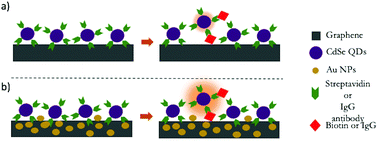Analyte-induced disruption of luminescence quenching (AIDLuQ) for femtomolar detection of biomarkers†
Abstract
Here, we present a graphene-based analyte-induced disruption of luminescence quenching (AIDLuQ) assay for specific detection of biomarkers with femtomolar sensitivity. In the AIDLuQ assay, antibody (Ab)-conjugated quantum dots (QDs) are initially deposited on graphene-coated paper. However, the emission from QDs is quenched due to resonance energy transfer to graphene. Upon the addition of an analyte (An) corresponding to Ab, the QDs–Ab–An complex is lifted above the surface resulting in the disruption of the quenching from graphene and the recovery of the luminescence of the QDs. The percentage of recovery depends upon the concentration of the analyte, allowing one to create standard curves for effective quantification. Despite its rapidity in assay time (15–20 min), the graphene platform has limited sensitivities. To further enhance this sensitivity, we embedded gold nanoparticles (Au NPs) into graphene paper. The graphene–Au paper exhibited excellent sensitivity in our model assay and was able to detect ∼10 fM biotin and IgG, unlike graphene that showed only ∼1 nM and ∼10 pM sensitivities.



 Please wait while we load your content...
Please wait while we load your content...